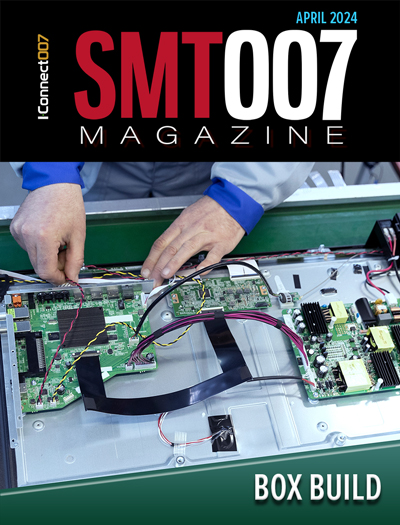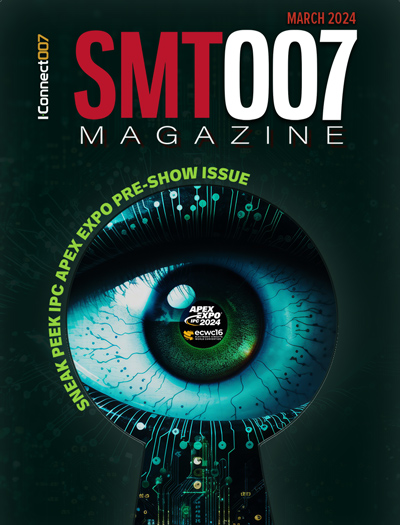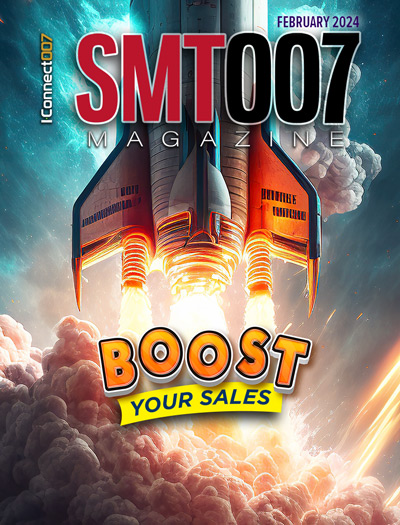-

- News
- Books
Featured Books
- smt007 Magazine
Latest Issues
Current Issue
Box Build
One trend is to add box build and final assembly to your product offering. In this issue, we explore the opportunities and risks of adding system assembly to your service portfolio.

IPC APEX EXPO 2024 Pre-show
This month’s issue devotes its pages to a comprehensive preview of the IPC APEX EXPO 2024 event. Whether your role is technical or business, if you're new-to-the-industry or seasoned veteran, you'll find value throughout this program.

Boost Your Sales
Every part of your business can be evaluated as a process, including your sales funnel. Optimizing your selling process requires a coordinated effort between marketing and sales. In this issue, industry experts in marketing and sales offer their best advice on how to boost your sales efforts.
- Articles
- Columns
Search Console
- Links
- Events
||| MENU - smt007 Magazine
An EMS Perspective on Inventory Management
August 27, 2020 | I-Connect007 Editorial TeamEstimated reading time: 1 minute
Foad Ghalili of Epoch International discusses the inventory management practices the company has in place between its two facilities in Fremont, California, and Dalian, China; and how upgrading to an electronic management system made maintaining a much larger inventory possible.
Barry Matties: We’re looking at inventory management on the EMS side. Foad, please share with us how Epoch manages inventory. It must be interesting because you have multiple locations. Is it computerized, manual, or a combination?
Foad Ghalili: Sure. Let me give you just the overall view of what we do. We use the Oracle E-Business Suite, which we purchased in 2008. All our ERP and MRP systems are done through that, and we generate a unique ID code for every item that we purchase everywhere, both in Fremont and in China. Every item comes with a barcode, which is identified there. And many of our material suppliers are also putting our barcodes on their label as it comes through. The system catches the barcodes as it comes through; then, it goes through the IQC system, and we transfer the material to our cabinet through our barcode system.
The cabinet is linked to our ERP system and controls everything that comes in and out of the cabinets. By the way, we have developed the interface modules in-house for the barcode system and all the software for the cabinet. We have done a lot of in-house software development to feed into the Oracle ERP system. Our feeders are also linked to the Oracle system. We know which component is fed where, so we have a fully integrated system.
In Fremont, we also have a cabinet. Of course, it’s not as sophisticated as what we have in China, but the two inventories are transparent to both facilities. We can look into their system, and they’re able to look at ours. Fremont is not on an Oracle system yet. We plan to move it into Oracle by the end of this year. We’re moving rapidly. We were having the team come here and set up, and then we got clogged up with COVID-19. In the future, both facilities will have visibility to each other’s operation.
To read this entire article, which appeared in the August 2020 issue of SMT007 Magazine, click here.
Suggested Items
Real Time with... IPC APEX EXPO 2024: MYCRONIC's Evolution and New Solutions
04/17/2024 | Real Time with...IPC APEX EXPOHenry Crandall interviews Kevin Clue, the vice president of global sales for MYCRONIC's High Flex division. They discuss the company's evolution, emphasizing its strong customer relationships and its role as a versatile, turnkey solution provider. Kevin unveils new solutions launched at IPC APEX EXPO, including an AI-integrated inspection system and the A40 pick-and-place platform. The conversation also touches on the increased use of AI and deep learning.
Australian Flow Batteries and The SCHMID Group Announce Groundbreaking Memorandum of Understanding
04/17/2024 | SCHMID GroupAustralian Flow Batteries Pty Ltd (AFB), a leader in innovative energy solutions and economical, safe, and reliable power storage, and SCHMID Energy Systems GmbH a company of the German SCHMID Group, a global technology leader with a rich history in delivering innovative solutions across multiple industries including Electronics, Renewables, and Energy Storage sectors, are thrilled to announce the signing of a Memorandum of Understanding (MoU)
Ansys Joins BAE Systems’ Mission Advantage Program to Advance Digital Engineering Across US Department of Defense
04/16/2024 | ANSYSAnsys announced it is working with BAE Systems, Inc., to accelerate the adoption of digital engineering and MBSE across the Department of Defense (DoD).
Designing Electronics for High Thermal Loads
04/16/2024 | Akber Roy, Rush PCB Inc.Developing proactive thermal management strategies is important in the early stages of the PCB design cycle to minimize costly redesign iterations. Here, I delve into key aspects of electronic design that hold particular relevance for managing heat in electronic systems. Each of these considerations plays a pivotal role in enhancing the reliability and performance of the overall system.
SIA Applauds CHIPS Act Incentives for Samsung Manufacturing Projects in Texas
04/16/2024 | SIAThe Semiconductor Industry Association (SIA) released the following statement from SIA President and CEO John Neuffer applauding semiconductor manufacturing incentives announced by the U.S. Department of Commerce and Samsung.


